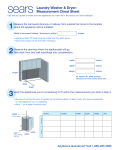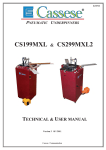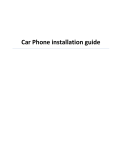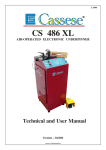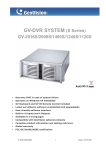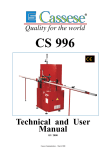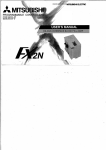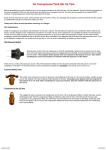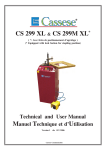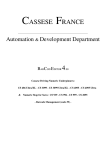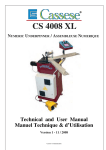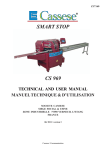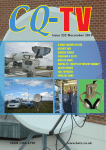Download to Manual
Transcript
UNDERPINNERS CS 88 & CS 89 FOOT-OPERATED PNEUMATIC Technical and User Manual Version 1 au 12 / 01 Cassese / Communication CS88 / CS 89 - Technical and User Manual CONTENTS PAGE N° INTRODUCTION 1 ACCESSORIES supplied with the rnachine: TECHNICAL SPECIFICATIONS OPTIONS WARRANTY PUTTING INTO OPERATION REASSEMBLY CS 89 AIR LINE FITTINGS 2-3 ADJUSTMENTS USE OF THE 2 SELF-ADJUSTING BACKFENCES SELECTION OF STAPLING POSITIONS SETTING AND STORING THE STAPLING POSITIONS SELECTION OF A TOP PRESSER END / ADJUSTMENT OF THE ASSEMBLY ANGLE 4 4-5 5 6 USE MEANS OF ASSEMBLY SETTING UP THE WEDGE CARTRIDGE UNDERPINNING THE FRAME 7-8 MAINTENANCE LUBRICATION CLEARING OF A WEDGE STUCK IN THE WEDGE DISTRIBUTOR IN CASE OF HAMMER AND WEDGE JAMMING CS 89 / SETTING THE LIMIT SCREW TROUBLE SHOOTING CS 88 / CS 89 12 / 01 Cassese Communication 9 10 11 12 INTRODUCTION You have just purchased a CS 88 / CS 89. We congratulate you on your excellent choice and we thank you for your trust. The CS 88 / CS89 benefits from our long of experience in manufacturing frame assembly machines which have made us famous. It will assemble wooden mouIdings of any profile (Patent n’8800188). The CS 88 / CS89 is designed to permit operators to work in front of the machine or behind it. Assembly is by metal wedges designed specially to ensure perfect joining. Use only wedges in cartridges manufactured by CASSESE® (CS trademark). Beware of copies. ACCESSORIES supplied with the rnachine: - 3 allen wrenches ( 2.5 - 3 - 6 ), - 1 replacement hammer, - 1 white triangle (for soft woods), - 1 black triangle for hard woods (mounted on machine) and its aluminium support, - 1 tool for removing wedges from distribution head, FIXING SCREW - 1 tube of grease - 1 Spacer bars for small mouldings. D - 3 sockets to attach the machine to the floor: Insert the part D of the sockets into the holes of the feet and then fix the sockets to the floor with a screw (not supplied). +(CS 89 only) 1 round rubber top presser (yellow for soft woods) + its aluminium support +(CS 89 only) air supply fittings : 1 male connector (on machine) + 1 quick release female connector + 2 (1 standard + 1 US) hose connectors. SPECIFICATlONS : Minimum width of moulding : 5 mm maximum: 100 mm Minimum height of moulding : 5 mm maximum: 85 mm Minimum size of frame : 60 x 60 mm (opening) Size of wedges in cartridges of 275 : 3, 4, 5, 7, 10, 12, 15mm Two types of wedges for : soft wood, hard wood. Net weight : 25 kg Dimensions : Width: 600 mm (24’’) Depth: 450 mm (18’’) Height: 1090 mm (431/2’’) ( CS 89 only) Energy needed : Compressed air 6-7 bars (+/- 100 p.s.i.) (CS 89 only) air supply : air regulator + manometer, air tube to be used (inside diameter 8mm) for the standard connector. OPTIONS Octogonal, hexagonal inserts or other to order. Other top pressers. WARRANTY CS 88 / CS89 is covered by a one year warranty for parts and labour and any manufacturing defects. Worn parts and parts damaged by use not in conformity with the terms of this manual are not covered by this warranty. 1 PUTTING INTO OPERATION For safety during transportation, the moving parts of your CS 88 – 89 have been blocked : these are the Top Presser Bracket (or Plunger) / Sliding Table / Horizontal (rebate) Clamp. For the explanations given in this manual, the operator must be standing at the back of the machine, keeping the machine slightly in his left. (See REFERENCE POSITION below). In this position, the operator is always in the same distance to the corner, regardless of the size of the frame. REFERENCE POSITION Fig N°1 TOP PRESSER BRACKET TOP PRESSER B2 RIGHT BACKFENCE B1 LEFT BACKFENCE AS ANGLE ADJUSTMENT SCREW SLIDING TABLE HORIZONTAL CLAMP WEDGE DISTRIBUTOR Fig N°2 IMPORTANT : For the best, and most efficient function of your CS 88-89 machine, we advise you to carry out the adjustments exactly in the order of this manual. STOP FOR STAPLING POINT INNER SIDE OF THE FRAME STOP FOR STAPLING POINT OUTER SIDE CS89 AIR CONNECTION SEE PAGE 3 OF THE FRAME Advice : to work frames of bigger sizes easily, you can put the CS 88-89 machines in front of your work bench (make sure that the work bench is not higher than the machine). The CS 88-89 machines have been conceived in a triangle form to fit any work bench : if you wish so, you can cut one of the corners of your work bench, to locate the machine in this corner. This way, while making big sized frames, you will not be using more than one of the corners of your work bench. 2 WIRE FOR WEDGE PUSHING SPRING CS 89 AIR LINE FITTINGS Advised way of fitting : USA STANDARD Male Connector on Machine Z 675 Z 675 quick release (Q/R) female air connector Z 749 Q/R US male connector Standard hose connector Z 701 Z 556 AIR SOURCE (compressor) D Manometer V EMERGENCY STOP The CS 89 is to be connected to the air source under its lower grey plate, at the level of air valve V. Then turn the air valve V to ON. Make sure that the air pressure shown on the manometer is 6 bar (85 p.s.i.) otherwise correct it with the regulator D. 3 SETTINGS USE OF THE 2 SELF-ADJUSTING BACKFENCES B Position a moulding against the LEFT backfence. Loosen the locking knob B. T Press the moulding against the table T, tilt the backfence so that it fits behind the moulding, then tighten knob B. Position the second moulding on the RIGHT backfence and repeat the operation. SELECTION OF STAPLING POSITIONS The CS 88 / 89 is designed to join mouldings in one or two places (positions) without limitation of the number of wedges in any of those places. The selection depends on the width and thickness of the moulding to join. 2 mm MINIMUM (Approx.1/8’’) 2 mm MINIMUM (Approx.1/8’’) As a general rule a MINIMUM 2 mm clearance (less than 1/8”) above the wedges shall be respected. Same sized wedges can be stacked in order to avoid to have to change the cartridge size when joining frames with different thickness. AS A GENERAL RULE, THE JOINING MUST BE CARRIED OUT AS CLOSE TO THE THICKEST MOULDING PART(S) AS POSSIBLE . 4 SETTING AND STORING THE STAPLING POSITIONS Release the stapling positioning stops, P1 and P2. B2 SLIDING TABLE REFERENCE POSITION B1 B P1 P2 1) UNDERPINNING WITH 2 STAPLING POINTS E Position the first moulding against stop B1 and slide it up to stop B2. P2 First stapling position: Outer side of the frame: Move the sliding table forwards and align the wedge outlet of the distributor D with the required stapling position. Slide stop P2 (outer stapling stop) until its buffer comes into contact with the sliding table, then lock it. B SORTIE AGRAFES D WEDGE OUTLET Second stapling position: Inner side of the frame: Move the sliding table backwards and align the wedge outlet of the distributor with the required stapling position. Slide stop P1 (inner stapling stop) against the sliding table, then lock it. P1 D 2) UNDERPINNING WITH 1 STAPLING POINT Position the right moulding against the self-adjusting backfence. Move the sliding table so that the wedge outlet coincides with the required stapling point. Lock the inner stapling stop P1. Then push the outer stapling stop P2 until its buffer B comes into contact with the sliding table, then lock it. 5 SELECTION OF A TOP PRESSER END Make sure that the distance between the moulding’s top and the presser’s bottom is not more than CS88 CS89 If the distance is bigger than this, use another 35 mm 50 mm (longer) top presser to reduce the distance. MAXIMUM MAXIMUM The triangle top pressers with their support that are included with your CS 88 / 89 give you the capacity to work mouldings up to 85 mm (1”½). For taller or complicated mouldings, there are other top pressers available from your regular source of Cassese products. BLACK TRIANGLE PRESSER WHITE TRIANGLE PRESSER GREEN ROUND RUBBER ENDS YELLOW ROUND RUBBER ENDS FOR HARDWOODS FOR SOFT WOODS FOR HARDWOODS FOR SOFT WOODS PRESSER MOULDING Fixing in support with 2.5 mm Allen key. 1 long and 1 short 1 long and 1 short Triangle top pressers are good for flat mouldings or for mouldings representing a flat or horizontal area to come down on. The round rubber ends are good for complicated forms (uphill, downhill or reverse mouldings). For very tall mouldings the round rubber ends can be also inserted into the top presser bracket without their support to gain capacity in height. ADJUSTMENT OF THE ASSEMBLY ANGLE If several cutting machines are being used in your production or if you receive your mouldings already cut by your suppliers (chop service), the angles of the mouldings will be slightly different from one cutting machine to the other. The joining angle of your CS 88 / CS 89 can be adapted to find precisely the cutting angle of your cutting machine. If the corner is open towards outside, unscrew (turn anti-clockwise) the angle adjustment screw AS (see Fig 1 page 1) a little to correct the fault and check again. Outside Inside If the corner is open towards inside, screw in (turn clock-wise) the angle adjustment screw AS (Fig 1 page 1) to correct the fault. If you get this result, check your cutting angle, which is wrong in this case because it is less than 45°. Carry out the adjustment of the angle of your cutting machine. IT IS IMPOSSIBLE TO MAKE A RECTANGLE FRAME WITH ANGLES SMALLER THAN 90°. 6 USE MEANS OF ASSEMBLY The joining is performed by using metal wedges, a Cassese invention, designed to ensure very tight corners. Five sizes are available : 5, 7, 10, 12 and 15 mm. They come in throw-away cartridges that are colourcoded per size for easy identification. Cartridge wedges exist in two versions : NORMAL for soft and normal timbers and HW for very hard timbers. These hardwood wedges are to be used only on hardwoods. Your CS 88 / CS 89 machine is designed to use all sizes of Cassese cartridges without having to change any parts on the machine or having to adjust anything. For the long term performance and reliability of your CS 88 / CS 89, only use genuine CASSESE cartridge wedges. Beware of counterfeit products. SETTING UP THE WEDGE CARTRIDGE Move the sliding table forwards to allow access to the cartridge. (1) 1 Pull the positioning cord back, using the ball as a grip. (2) 3 Push the cartridge fully home in the distributor slot. (3) Release the wedge pusher cord carefully to avoid damaging the pusher and spring. Note: For easier changing of the wedge magazine during operation, the wedge cartridge can be accessed by lifting the sliding table from the rear with the finger. 2 7 UNDERPINNING THE FRAME The stapling points are defined (see Defining the stapling point, page 5). The joint angle has been checked (see Setting the joint angle, page 6). The distance between the top of the moulding and the bottom of the top clamp is outside permissible maximum. (See Choice of top clamp, page 6). Correct size wedges (normal wood or hard wood) have been loaded in the machine. Position the first moulding against the right stop and slide it up to the left stop. Keeping the first moulding secure, position the second moulding against the left stop, then slide it into contact with the first moulding. Position the rebate clamp: Unscrew the knob of the top clamp, then move the top clamp against the 2 mouldings, without forcing. Lock the top clamp knob again, without pushing it. Clearance of around 1 mm is left to make it easier to move the mouldings during assembly. Move the sliding table forwards or backwards to stop P2 or P1 (page 5). Then: CS 88 Keeping the mouldings secure, slowly push down the pedal. When the top clamp comes into contact with the moulding, speed up the movement so that the wedge is inserted more easily. To stack wedges* - Release the pedal until the top clamp begins to lift. - Push the pedal down again. * When stacking wedges, the sliding table should be locked in place. CS 89 Keeping the moulding secure, gently push the pedal so that the two mouldings are secured by the rebate clamp. Then press the pedal down fully to insert the wedge. If there is a second stapling position, keep your foot pressing down on the pedal, move the sliding table to the second position, raise your foot slightly then push fully down to insert the second wedge. Then release the pedal completely. Note: If several wedges are inserted, raise your foot slightly to keep horizontal pressure on the mouldings, then push fully down: the second wedge is inserted and pushes the first wedge further in. 8 MAINTENANCE 1) LUBRICATION Periodically, remove the wedge distributor (Fig 1, block H) and clean it (by air gun) without dismounting it. It is recommended to lubricate the hammer (driver blade) periodically. To do so, remove the wedge distributor (blockH) and put a small quantity of grease in the bottom hole of the wedge distributor. The hammer will be lubricated every time it crosses the wedge distributor. 2) CLEARING OF A WEDGE STUCK IN THE WEDGE DISTRIBUTOR If you push the foot pedal half way and release, a wedge may be half engaged in the wedge distributor. In this case, - Close the air valve. - Try to remove the cartridge that is in position. If it resists, use the wedge removal tool to push down the wedge back in the cartridge. - Pay attention not to make penetrate the tool more than 6mm (¼”) into the wedge distributor. It is important not to leave a wedge half engaged in the wedge distributor, as it may cause the insertion of two wedges when you join the next corner or may cause the jamming of the hammer (the driver blade) in the wedge distributor. - In case of the hammer (driver blade) jamming with a wedge in the wedge distributor, see the following section (3). WEDGE REMOVING TOOL 6mm MAXIMUM ( 1/4’’ ) DISTRIBUTOR ( BLOCK H ) WEDGE EXIT 9 3) IN CASE OF HAMMER AND WEDGE JAMMING BLOCK H A D GF1 GF2 RULER D locking screw E B HAMMER C fig 0 BLOCK H HAMMER RETAINING SCREW WEDGE DISTRIBUTOR (BLOCK H) SLIDING TABLE BLOC H SCREW POSITIONS LOCKING SCREW Z1394 PROCEDURE - Remove the cartridge that is on machine, and the top presser. - Using the 3mm Allen key, loosen the locking screw of the wedge distributor Block H. - Then lift the top presser’s bracket arm by hand. The wedge distributor will come out of its housing. Remove it from the machine. - The old hammer (wedge driver blade) is stuck in the wedge distributor : first try to remove it with a pair of pliers. If not possible, unscrew the two central screws (GF1, GF2) that hold the fixed (square) guide of Block H in place. Use for this the smaller (2.5mm) Allen key supplied with the machine. Remove the fixed guide completely to free the old hammer. If still not possible to get rid of the old hammer, remove the four screws (A, B, C, D) and open the block H. (Two factory set locator pins E & F allow the plates to be re-positioned precisely again.) - Remove the old hammer. Assemble the Block H back again. Putting a new hammer (driver blade) : - Put a drop of grease in the bottom hole of the wedge distributor (block H). - Insert a new hammer into block H with the hole of the hammer downwards. - Re-position the wedge distributor in its housing on the machine with the window towards the cartridge. - If the upper end of the hammer stays out of the block H, push it fully in with a piece of wood or moulding. While keeping the moulding in place (on block H) and pressing on it, pull up the top presser’s bracket arm Po (Fig1 p1) with a quick movement. The new hammer must have taken its position in the mechanism automatically. - Check with your finger or with a ruler that the block H does not stay out of the machine (higher than the work level) and tighten the locking screw of block H. No need to tighten too much. - The machine is ready to work again. If you have any difficulty to remove the block H from the machine, push down with your hands the top presser’s bracket arm.This should free the block H that is stuck with the hammer. 10 CS 89 SETTING THE LIMIT SCREW WARNING! ONLY CARRY OUT THIS OPERATION IF IT IS RECOMMENDED IN THE TROUBLESHOOTING REMEDIES AT THE END OF THE MANUAL. LIMIT DETECTOR LIMIT SCREW CS 89 E 1) Take out the wedge cartridge. 2) Reduce the air pressure to 3 bars. 3) Set the plunger at less than 50 mm (2’’) from the table. 4) Holding nut E, turn the limit screw through 2 to 3 turns. 5) Press the pedal as if to start up stapling; as the limit detector is not actuated, the plunger remains in low position. 6) Unscrew the limit screw until the plunger moves upwards. 7) Once the plunger has lifted, unscrew the limit screw by an additional quarter turn. 11 TROUBLESHOOTING IF THE PROPOSED REMEDIES DO NOT SOLVE THE PROBLEM CONTACT THE AFTER-SALES SERVICE FAULT NO WEDGES ARE INSERTED INTO THE MOULDING POSSIBLE CAUSES 88-89 - The wedge cartridge is empty - Fit a new wedge cartridge 88-89 - The wedge distributor is clogged - Clean it 88-89 - The wedge spring is broken or relaxed - Check the condition of the spring and replace if necessary - Change the wedge driver blade (page 10) - Reposition the plunger within permissible maximum distance (page 6) - Secure the moulding firmly on the table 88-89 - The wedge driver blade is broken THE WEDGE IS NOT FULLY INSERTED INTO THE MOULDING REMEDIES 88-89 - Top clamp / Moulding distance not within permissible maximum 88-89 - Moulding not adequately secured on the table 88-89 - Wedge driver blade damaged 89 - Limit screw incorrectly set 89 - Air supply pressure less than 6 bar - Change the wedge driver blade - Check the setting of the limit screw - Increase the pressure THE WEDGE BREAKS 88-89 - Hard wood ANGLE OFFSET 88-89 - The first moulding was not pushed firmly against the left stop (page 5) MOULDINGS DIFFICULT TO MOVE 88-89 - The rebate clamp is too tight against the - Use hard wood wedges (page 7) mouldings. - When the rebate clamp is tightened do not push it towards the mouldings 88-89 - Too much grease on the wedge driver - Clean the wedge driver blade - Corner open on inside 88-89 - Bad cut - Repeat the cut - Corner open on outside 88-89 - Incorrect setting - Loosen the AS screw (page 2-4) to compensate for opening STAINS ON BACK blade POOR JOINING - Opening on top and bottom 88-89 - Incorrect setting of stops of joint - Check the self-adjusting backfences before starting underpinning - Mouldings marked by triangle rubber top pressor - Use a suitable triangle rubber top pressor (page 6) 88-89 - Triangle rubber top pressor for hard wood used on soft wood THE WEDGE DRIVER BLADE DOES NOT LOWER 88-89 - Misalignment - Contact after-sales service THE PLUNGER DOES NOT LIFT 88-89 - Wedge jammed in the wedge distributor - Dismantle the wedge driver blade to remove the wedge (page 10) 89 - Limit screw incorrectly set 88-89 - Distance between bottom of top clamp and top of moulding outside permissible maximum 12 - Reset the limit screw (page 11) - Reposition the plunger and expel any wedge that may have gone into the wedge distributor using the tool supplied (page 9)















